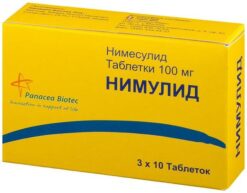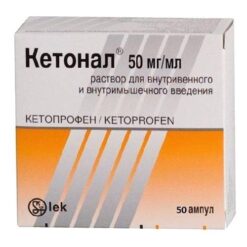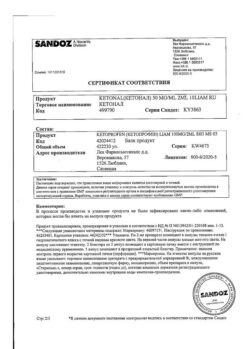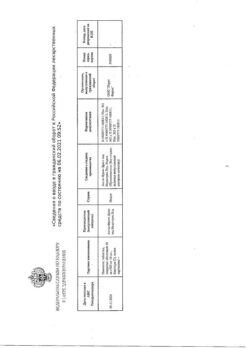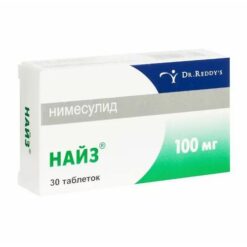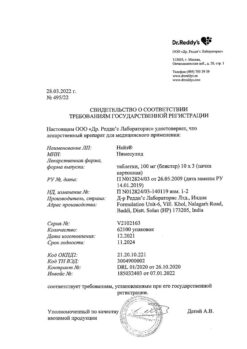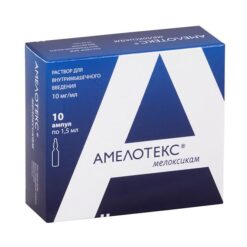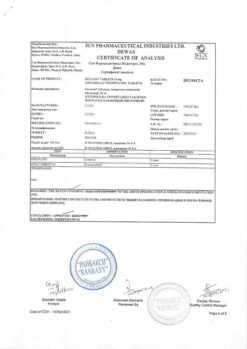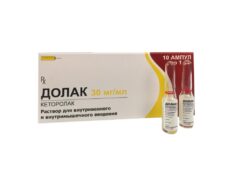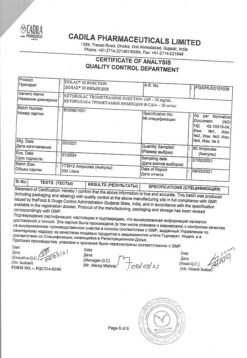No products in the cart.
Migrenol Extra, tablets, 16 pcs.
€1.00
Out of stock
(E-mail when Stock is available)
Description
Mygrenol Extra has analgesic, anti-inflammatory, antipyretic effect.
Caffeine has psychostimulant (stimulates the psychomotor centers of the brain), analeptic effect, enhances the effect of analgesics, eliminates drowsiness and fatigue, increases physical and mental performance.
Paracetamol has antipyretic and analgesic effect (due to inhibition of COX and inhibition of prostaglandin synthesis it affects the thermoregulation center in the hypothalamus and the conduction of pain impulses in the CNS).
Acetylsalicylic acid has antipyretic and anti-inflammatory effects, reduces pain, especially caused by inflammation, and moderately inhibits platelet aggregation and thrombosis, improves microcirculation in the inflamed area.
Pharmacokinetics
Paracetamol is easily absorbed in the gastrointestinal tract, the maximum plasma concentrations are detected from 30 minutes to 2 hours after intake. Paracetamol is metabolized in the liver and excreted by the kidneys, mainly as glucuronides and sulfate coneogates. Less than 5% of paracetamol is excreted unchanged. The elimination half-life varies from 1 to 4 hours. Binding to plasma proteins is insignificant at normal therapeutic doses; however, it increases with increasing dose. Hydroxylated metabolite, which is formed in small amounts in liver under the influence of mixed oxidases and is usually neutralized by binding to glutathione, may accumulate in paracetamol overdose and cause liver damage.
Acetylsalicylic acid is rapidly and completely absorbed, undergoing rapid hydrolysis in the GI tract, liver and blood to form salicylates, which undergo further metabolism, mainly in the liver.
Caffeine is completely and quickly absorbed. Maximum concentrations are observed between 5 and 90 minutes after ingestion on an empty stomach. In adults excretion occurs almost entirely through hepatic metabolism. There is marked variability in individual elimination values in adults. Mean plasma elimination half-life (T1/2) is 4.9 hours, with a range of 1.9-12.2 hours. Caffeine is distributed in all body fluids. The binding of caffeine to plasma proteins is 35%. Caffeine is almost completely metabolized by oxidation, demethylation and acetylation and excreted by the kidneys. The main metabolites are 1-methylxanthine, 7-methylxanthine, 1,7-dimethylxanthine.
Indications
Indications
Pain syndrome (mild to moderate):
Active ingredient
Active ingredient
Composition
Composition
White film-coated tablets, round, embossed “FR9” on one side; white on the break.
1 tabletacetylsalicylic acid 250 mg
caffeine 65 mg
paracetamol 500 mg
Particular substances:
carboxymethylamylopectin sodium – 24 mg,
starch – 22.8,
povidone (K-30) – 7.4,
stearic acid – 8 mg,
microcrystalline cellulose – 16 mg.
How to take, the dosage
How to take, the dosage
The drug is taken orally with or after meals.
To relieve pain syndrome in adults and children over 15 years
Adults with fever syndrome
The average daily dose is 3-4 tablets, the maximum daily dose is 8 tablets. The course of treatment should not exceed 7-10 days.
The drug should not be taken for more than 5 days as an analgesic and for more than 3 days as an antipyretic (without a doctor’s prescription and monitoring).
Interaction
Interaction
Caffeine. Accelerates the absorption of ergotamine, reduces the absorption of calcium preparations in the gastrointestinal tract, reduces the effect of narcotic and sleeping pills.
Acetylsalicylic acid. Increases the effect of heparin, indirect anticoagulants, reserpine, steroid hormones and hypoglycemic drugs. Concomitant use with other NSAIDs, methotrexate increases the risk of side effects. Reduces the effectiveness of spironolactone, furosemide, hypotensive drugs and antipodagric drugs that promote uric acid excretion.
Paracetamol. Barbiturates, rifampicin, salicylamide, antiepileptic drugs and other stimulants of microsomal oxidation contribute to the formation of toxic metabolites of paracetamol, affecting liver function. Metoclopramide accelerates the absorption of paracetamol. Under the influence of paracetamol, the T1/2 of chloramphenicol is increased 5-fold. When taken repeatedly, paracetamol may increase the effect of anticoagulants (coumarin derivatives). Simultaneous use of paracetamol and ethanol increases the risk of hepatotoxic effects.
Special Instructions
Special Instructions
The excessive use of caffeine-containing products (coffee, tea) during treatment may cause symptoms of overdose.
Long-term (more than 1 week) treatment requires monitoring of peripheral blood picture and functional state of the liver. Without physician’s consultation it is taken not more than 3 days for febrile syndrome and not more than 5 days for pain syndrome.
During treatment it is necessary to refrain from using ethanol (increased risk of hepatotoxicity). It is necessary to refrain from drinking alcohol while taking the drug due to the increased risk of liver damage and gastrointestinal bleeding.
When prolonged use of the drug it is necessary to monitor peripheral blood and liver function status. Because acetylsalicylic acid slows blood clotting, the patient should warn the physician in advance about taking the drug if he is going to have surgery.
Acetylsalicylic acid at low doses reduces uric acid excretion. In patients with the appropriate predisposition, this may in some cases provoke an attack of gout.
Influence on the ability to drive vehicles and operate moving machinery
There have been no reported effects of the drug on the ability to drive vehicles and operate machinery.
Contraindications
Contraindications
Side effects
Side effects
Allergic reactions: skin rash, itching, angioneurotic edema, erythema malignant exudative (Stevens-Johnson syndrome), toxic epidermal necrolysis (Lyell syndrome), bronchospasm.
Gastrointestinal disorders: gastralgia, nausea, vomiting, hepatotoxicity, gastrointestinal erosive ulcers.
Cardiovascular system: tachycardia, increased blood pressure.
Sensory system disorders: visual impairment, tinnitus, deafness.
CNS disorders: dizziness, headache.
Urinary system disorders: nephrotoxicity, kidney damage with papillary necrosis.
Anemia, decreased platelet aggregation, thrombocytopenia, hypocoagulation, hemorrhagic syndrome (new bleeding, bleeding gums, purpura, etc.).
Reye syndrome in children (hyperpyrexia, metabolic acidosis, nervous system and mental disorders, vomiting, liver dysfunction).
Overdose
Overdose
Symptoms due to the presence of paracetamol: during the first 24 hours pale skin, nausea, vomiting, anorexia, abdominal pain, impaired glucose metabolism, metabolic acidosis. Symptoms of liver dysfunction may appear 12-48 hours after overdose. In severe overdose – renal failure with progressive encephalopathy, coma, death; acute renal failure with tubular necrosis (including in the absence of severe liver damage); arrhythmia, pancreatitis.
Symptoms due to the presence of acetylsalicylic acid: in mild intoxication – nausea, vomiting, dizziness, tinnitus, visual disturbances, severe headache; in severe intoxication – hyperventilation of the lungs of central genesis (shortness of breath, choking, cyanosis, cold sticky sweat, respiratory paralysis), respiratory acidosis. The greatest risk of developing chronic intoxication is noted in children and elderly people when taking more than 100 mg/kg/day for several days.
The symptoms due to the presence of caffeine are: Gastralgia, agitation, anxiety, agitation, motor anxiety, confusion, delirium, dehydration, tachycardia, arrhythmia, hyperthermia, rapid urination, headache, increased tactile or pain sensitivity, tremor or muscle twitching; nausea and vomiting, sometimes with blood; tinnitus, epileptic seizures (tonic-clonic in acute overdose).
Treatment: continuous monitoring of acid-base status and electrolyte balance. Depending on the state of metabolism – administration of sodium bicarbonate, sodium citrate or sodium lactate. Increasing alkalinity increases the excretion of acetylsalicylic acid by alkalizing the urine. Gastric lavage during the first 4 h, provocation of vomiting, administration of activated charcoal, laxatives, administration of SH-group donators and precursors of glutathione methionine synthesis within 8-9 h after overdose and of acetylcysteine – within 8 h.
Pregnancy use
Pregnancy use
The use of the drug during pregnancy and during breast-feeding is contraindicated.
Preventive use in children
In case of fever syndrome the drug is contraindicated in children under 18 years of age; in case of pain syndrome – in children under 15 years of age (risk of Reye syndrome in children with hyperthermia due to viral diseases).
Similarities
Similarities
Additional information
| Shelf life | 3 years |
|---|---|
| Conditions of storage | In a dry, light-protected place |
| Manufacturer | Fore Ventures, USA |
| Medication form | pills |
| Brand | Fore Ventures |
Related products
Buy Migrenol Extra, tablets, 16 pcs. with delivery to USA, UK, Europe and over 120 other countries.


